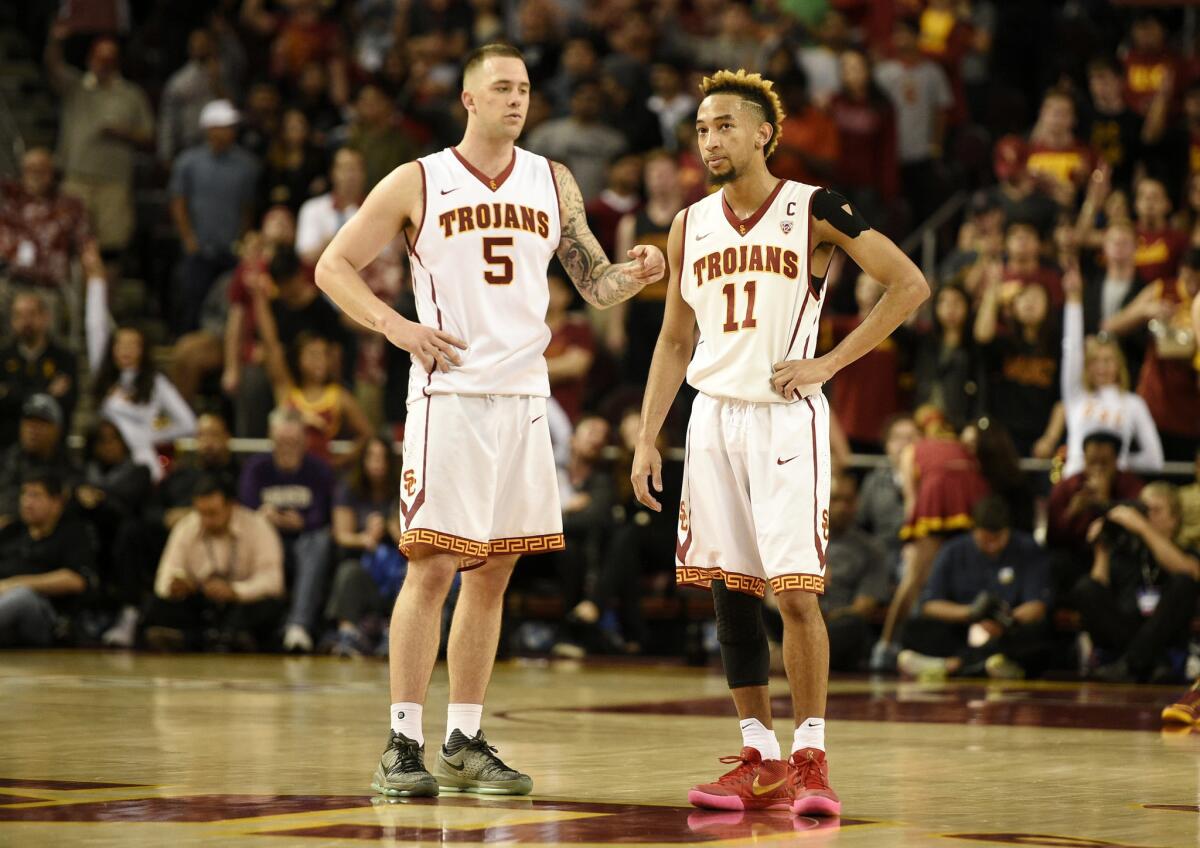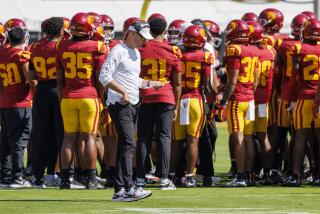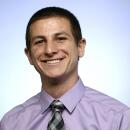Andy Enfield had to be a salesman as well as coach at USC

USC guards Katin Reinhardt (5) and Jordan McLaughlin (11) talk during the second half of a game against Washington.
- Share via
There was no videotape to watch, no game to study.
In April 2011, few people outside the state of Florida had heard of Andy Enfield or the college basketball team he’d just been hired to coach, Florida Gulf Coast.
Brett Comer had, but only because Enfield was recruiting him.
“There was really no offense to watch film on or know what was going to happen,” Comer said. “But he told me when he came to visit me, ‘We’re going to play up and down, we’re going to play fast, we’re just going to go.’”
Committing on faith, Comer became Enfield’s first recruit.
Enfield’s time at Florida Gulf Coast became invaluable when he was hired as USC’s coach in April 2013. At both schools, Enfield started nearly from scratch.
“We had kind of the same pitch,” Enfield said after a recent practice. “We have a lot of roster spots available. Come in and you’ll play early in your career and build something.”
The Florida Gulf Coast players, like Comer, lacked many other options. But after the Eagles came out of nowhere to reach the NCAA Sweet 16 in 2013, Enfield’s first USC recruiting class, which became the backbone of a team now fighting for its first NCAA tournament berth since 2011, was different.
Players such as Nevada Las Vegas transfer Katin Reinhardt and Etiwanda High guard Jordan McLaughlin attracted plenty of suitors.
What led them to commit to a program with a new coach and a depleted roster?
When Reinhardt announced he was transferring from UNLV, no one could make much sense of it. Playing time wasn’t an issue. He averaged 29.1 minutes as a freshman and led the team in three-point attempts. And UNLV went 25-10 and reached the NCAA tournament that season. Reinhardt also got along well with Coach Dave Rice.
So why was he transferring?
Reinhardt told reporters that he wanted to handle the ball and distribute more.
But recently, Reinhardt provided a more complete explanation. He said he felt his style didn’t fit perfectly into UNLV’s system, but that wasn’t the biggest reason.
The temptations of playing in Las Vegas had started to worry him.
“You think SC football is big, it’s 10 times bigger out there for basketball. You can do whatever you want,” Reinhardt said. “You can only say no so many times.”
Reinhardt knew he had to get away. His decision came down to a choice between Florida, Syracuse and USC — two established programs and one unknown.
Enfield, again, sold his vision. Reinhardt wouldn’t be a point guard, but Enfield’s system emphasized freedom and quick ball movement.
Reinhardt bought in.
“If you rebuild that program, then everybody talks about that for the rest of your life,” Reinhardt said.
Reinhardt transferred to USC before the 2013-14 season. Enfield had his first player.
Around the same time, McLaughlin was nearing his decision. At first, McLaughlin thought he’d end up at UCLA, Kansas or Indiana.
“USC wasn’t really at the top of my list,” McLaughlin said.
UCLA became an early favorite. McLaughlin visited the campus and the coaching staff called him often.
Then McLaughlin heard UCLA’s attention was drifting toward Josh Perkins, a point guard from Colorado.
“He took the visit there and everything,” McLaughlin said of Perkins, who ended up at Gonzaga, “and I had my visit here.”
It was the moment he first envisioned himself at USC.
When he was recruiting a point guard at Florida Gulf Coast, Enfield could only describe a plan. Now he had evidence.
The coach put on a videotape of the Eagles’ “Dunk City” offense and told McLaughlin to watch the point guard.
The player: Brett Comer.
McLaughlin imagined himself in his position, running and throwing lobs. Not long afterward, he verbally committed to sign with USC.
Like Reinhardt, McLaughlin expected some bumps in Enfield’s first season, before the first recruiting class arrived. The Trojans went 11-21. After that, McLaughlin said, “I truly believed that we could’ve been a tournament team.”
But when the recruiting class came in last season, USC went 12-20 and won only three Pac-12 Conference games.
“I don’t know what they expected,” Enfield said. “We were trying to build a program with young players.”
That required patience, which wasn’t easy on the players. Reinhardt said he’d never lost so much in his life. He’d never experienced such frustration.
What a difference a year has made. With six regular-season games remaining, including Wednesday night against Colorado at the Galen Center, USC (18-7) figures to make the NCAA tournament, barring a collapse.
Comer, who follows USC because of Enfield, said the Trojans are beginning to resemble the 2013 Florida Gulf Coast team McLaughlin watched that day in Enfield’s office.
“They showed me the vision,” McLaughlin said. “And it’s all coming true.”
NEXT UP
USC VS. COLORADO
When: Wednesday, 8 p.m. PST.
Where: Galen Center.
On the air: TV: ESPNU; Radio 710.
Update: USC (18-7, 7-5 in the Pac-12 Conference) was swept last weekend in its trip to Arizona to fall to 2-5 in conference on the road and 0-4 overall as a ranked team. But the Trojans haven’t lost this season at home, nor have they lost three games in a row. Colorado (19-7, 8-5) is a surprising contender for the conference title after finishing eighth last season. The Buffaloes managed narrow victories over Washington and Washington State last week despite the absence of leading scorer and rebounder Josh Scott. Coach Tad Boyle said Scott’s availability for the USC game is uncertain.
More to Read
Go beyond the scoreboard
Get the latest on L.A.'s teams in the daily Sports Report newsletter.
You may occasionally receive promotional content from the Los Angeles Times.







